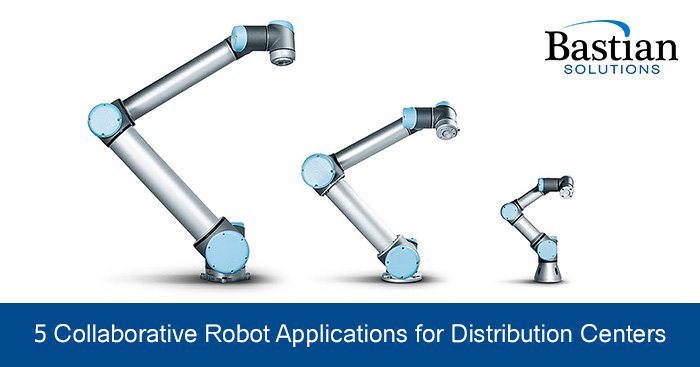
5 Cobot Applications for Distribution Centers
Greg Conner | 22 August 2018
How cobots can help fill the distribution center labor gap
Having trouble filling open positions within your distribution center? You’re not alone!
With the US unemployment rate at historically low levels, distribution center managers are not only struggling to fill open positions, they’re having to fight harder to retain current employees. In 2017, it was reported that warehouse worker wages rose nearly 5% in some areas of the U.S. Add to this the growing number of workers needed to meet demand in ecommerce, and the problem quickly compounds.
So, what is the answer? How about cobots?
What is a Cobot?
A collaborative robot, or cobot, is an industrial robot intended to physically interact with humans in a shared workspace. Cobots are designed for the repetitive tasks involved in distribution and manufacturing, helping increase throughput while reducing errors. Unlike traditional industrial robots which typically require separate, protected workspaces surrounded by safety fencing, cobots and people can work side-by-side. Additionally, they have a lower overall investment and require less sophisticated controls programming. Often a cobot’s overall investment is between $50-80k, compared to $200k and up for a traditional industrial robot.
While automation is key to the evolving distribution warehouse, many tasks still require the dexterity of a manual operation. Luckily, technology is catching up. Today’s advanced EoAT (End of Arm Tooling) will enable cobots to perform similar manual tasks to supplement the human workforce. Plus, since they never get tired or require sick time, they don’t require down time. Cobots can work around the clock performing simple, repetitive tasks to free up humans for more important skilled labor.
Below are 5 potential applications for a cobot within a distribution center:

1. Picking – Unless you’ve been living under a rock, you’ve heard of goods-to-person picking solutions. This technology is quickly advancing distribution center productivity. The next leap is goods-to-robot. In this scenario, the person picking the order will be assisted by or replaced with a cobot equipped with vision cameras. Robotic picking also leads to fewer miss picks given the ability of the vision system to verify each selection. Bastian Solutions currently has several Goods-To-Robot pilot projects in the field, and these solutions are sure to become mainstream very soon.

2. Packing – Another application in which cobots can add value is by automating the packing process. Polybag filling is a very labor-intensive job. Paired with an automatic bagging machine, a cobot could turn a semi-automated operation into a fully automated operation

3. Palletizing – We are all familiar with robotic palletizers and the benefits they provide. However, some of their biggest drawbacks include initial cost, complex programming and the need for restrictive safety fencing. For light to medium duty palletizing applications where rates are not very high, a cobot could be a cost-effective solution. Especially considering how easy cobots are to program or “teach,” they could be a fantastic way to automate the outbound shipping process.

4. Inspection/QC – Many distribution centers require picked products to be inspected or quality checked prior to packaging and shipping. There are many methods, such as weight check or vision, that can help automate these processes. However, cobots could be a cost-effective solution. For example, a cobot could be positioned alongside a conveyor and programed to lift out one of the contents of every 10 packages that passes by. The cobot could lift the product out and scan or capture an image of the product to ensure accuracy and verify orders.

5. Returns Processing and Sorting – In many distribution centers product returns account for a very high percentage of overall labor. Cobots could be utilized to unload containers of returned product and load these returns onto a conveyor. They could also be equipped with vision technology and utilized to sort product into bins of like product.
Cobots are quickly taking the industry by storm and offer significant advantages. From picking, packing, palletizing and beyond, there are many distribution center applications that can benefit from using cobots as a cost-effective automation solution. Contact us today to help evaluate your collaborative robot application!
Christopher Dyjak is Regional Manager of Bastian Solutions Cincinnati. In this role, he oversees all field application engineers and customer projects within the Ohio valley region and surrounding areas. Chris has more than 20 years of design engineering and technical sales experience.
Greg is the SVP of Corporate Development and Marketing at Bastian Solutions. A proud Purdue University graduate, at Bastian he works to identify and drive strategies to propel the company forward. His responsibilities include identification of emerging technologies, forming strategic partnerships and M&A activities and execution of the strategic planning process. He carries with him years of experience in the field, having previously worked as a project engineer, field application engineer and regional director of Indiana.
Comments
No comments have been posted to this Blog Post
Leave a Reply
Your email address will not be published.
Comment
Thank you for your comment.